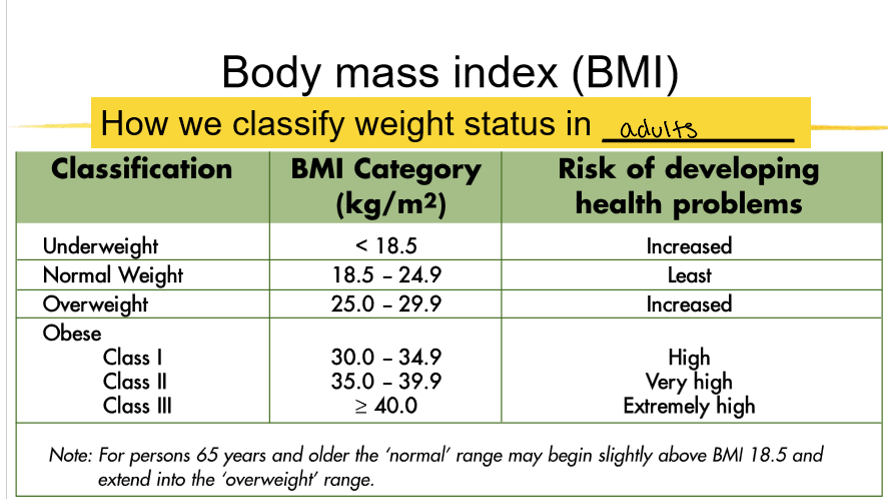asynchronous week 3 nutrition assessment
1/8
There's no tags or description
Looks like no tags are added yet.
Name | Mastery | Learn | Test | Matching | Spaced |
|---|
No study sessions yet.
9 Terms
define and describe nutrition assessment
determining nutritional status by analyzing individual’s ABCD (anthropometric, biochemical, clinical,dietary) history and current data
describe specific examples of anthropometric measurements and their strengths and limitations
measurement of physical dimensions and gross composition of the body. height weight mid upper arm circumference MUAC
MUAC only good for children, easy to use, cost effective
recumbent length: measured if child cannot stand erect without assistance (uncomfortable for child)
define describe evaluate: stunting, wasting, underweight, and body mass index BMI
wasting: low weight for height, acute malnutrition
stunting: low height for age, chronic malnutrition
underweight: low weight for age in children, chronic and acute
BMI: how we classify weight status in adults

briefly describe how biochemical measurements can be used in nutrition assessments
measure nutrient or its metabolite in blood, urine, feces
differentiate between clinical signs and symptoms
signs observed by trained professional, affected person is usually unaware
symptoms are subjective, reported by affected person
identify and explain some useful clinical signs of malnutrition (including bilateral pitting edema)
depigmentation of hair
bitot’s spots= xeropthalmia night blindness
paleness of skin near eyes= iron deficiency anemia
nails traverse ridgiing = protein deficiency \
bilateral pitting edema sign of severe acute malnutrition (press with thumb and remove thumbs, if indent remains = pit edema)
summarize the limitations of a physical examination in the assessment of nutritional status
signs and symptoms can be hard to interpret, not specific and can mean its cause of other deficiencies too
examiner inconsistencies
inter-individual variability
identify, describe, evaluate the strengths and limitations of types of dietary assessments (24 hour recall, food records, food frequency questionnaires)
24 hour recall
strengths: quick, cheap, easy for person to do, doesnt alter diet
limitations: relies on memory, one recall doesnt represent individuals typical intake
food records
strengths: doesnt rely on memory, provides detail, insight into eating habits, multiple days more representative
limitations: takes time to complete, recording diet alters diet, lots of data
food frequency questionnaires
strengths: self administered, cheap, more representative of intake, cheap
limitations: might not include foods usually consumed by persons, might not include portion size
determine which method of dietary assessment would be most appropriate in various settings
depending on the goal, resources, respondents, and setting